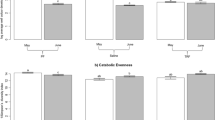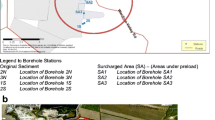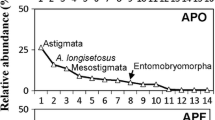Abstract
Oil sands mining in the Athabasca oil sands region disturbs large tracts of peatlands as the vegetation-soil layer must be removed. Processing oil sands produces large volumes of wet material containing oil sand process-affected water (OSPW) that has elevated concentrations of sodium (Na) and naphthenic acids (NAs). Attempts to reclaim mined landscapes to peat-forming systems command knowledge of the transport, fate and impact of OSPW in organic soils. Four mesocosms placed in a greenhouse were randomly assigned with two treatments: 1) a moss carpet (Bryum pseudotriquetrum) and 2) graminoids (Carex aquatilis and Calamagrostis stricta). Transport of Na and NAs through peat was significantly delayed by sorption and diffusion in peat matrix. After two growing seasons of receiving OSPW, the graminoid plants continued to grow without showing stress from OSPW, while mosses showed a considerable decline in health. Microorganisms were more active under sedges than mosses and their activity varied over time either because of seasonal variation or as a consequence of variation in Na concentration. The findings of this study are limited due to the small number of replicates and the lack of a control, but represent a first step towards the creation of peatlands in the post-mined areas.








Similar content being viewed by others
References
Albert R, Popp M (1977) Chemical composition of halophytes from the Neusiedler Lake region in Austria. Oecologia 27:157–170
Alberta Environment (1999) Regional Sustainable Development Strategy for the Athabasca Oil Sands Area.1/754, Alberta Environment, Government of Alberta. Edmonton, AB
Alberta Environmental Protection (1996) Fort McMurray-Athabasca subregional integrated resource plan. Edmonton, AB
Andersen R, Grasset L, Thormann M, Rochefort L, Francez AJ (2010) Changes in microbial structure and function following Sphagnum peatland restoration. Soil Biology and Biochemistry 42:291–301
Anderson MJ (2001) A new method for non-parametric multivariate analysis of variance. Austral Ecology 26:32–46
Apostol KG, Zwiazek JJ, MacKinnon MD (2004) Naphthenic acids affect plant water conductance but do not alter shoot Na+ and Cl− concentrations in jack pine (Pinus banksiana) seedlings. Plant and Soil 263:183–190
Artz RRE, Chapman SJ, Campbell CD (2006) Substrate utilization profiles of microbial communities in peat are depth dependent and correlate with whole soil FTIR profiles. Soil Biology and Biochemistry 38:2958–2962
Artz RE, Anderson CA, Chapman SJ, Hagn A, Schloter M, Pott JM, Cambell CD (2007) Changes in fungal community composition in response to vegetational succession during the natural regeneration of cutover peatlands. Microbial Ecology 54:508–522
Baldwin D, Rees G, Mitchell A, Watson G, Williams J (2006) The short-term effects of salinization on anaerobic nutrient cycling and microbial community structure in sediment from a freshwater wetland. Wetlands 2:455–464
Boelter DH (1976) Methods for analysing the hydrological characteristics of organic soils in marsh-ridden areas. In: Hydrology of Marsh-Ridden Areas, Proceedings of IASH Symposium Minsk, 1972, IASH, UNESCO, Paris, 161–169
Bott R (2007) Canada’s Oilsands. Canadian Centre for Energy Information. Calgary, AB
Brendell-Young LI, Bennett KE, Crowe A, Kennedy CJ, Kermode AR, Moore MM, Plant AL, Wood A (2000) Ecological characteristics of wetlands receiving an industrial effluent. Ecological Applications 10:310–322
Campbell CD, Chapman SJ, Cameron CM, Davidson MS, Potts JM (2003) A rapid microtiter plate method to measure carbon dioxide evolved from carbon amendments so as to determine the physiological profiles of soil microbial communities by using whole soil. Applied & Environmental Microbiology 69(6):3593–3599
Clymo RS (1963) Ion exchange in Sphagnum and its relation to bog ecology. Annals of Botany (London) 27:309–324
Cooper A (1982) The effects of salinity and waterlogging on the growth and cation uptake of salt marsh plants. The New Phytologist 90:263–275
Cooper NJ (2004) Vegetation community development of reclaimed oil sands wetlands. M.Sc Thesis. University of Alberta, Edmonton, Canada
Crowe AU, Han B, Kermode AR, Brendell-Young LI, Plant AL (2001) Effects of oil sands effluent on cattail and clover: photosynthesis and the level of stress proteins. Environmental Pollution 113:311–322
Crowe AU, Plant AL, Kermode AR (2002) Effects of an industrial effluent on plant colonization and on the germination and post-germinative growth of seeds of terrestrial and aquatic plant species. Environmental Pollution 117:179–189
Curlevski NJA, Artz RRE, Anderson IC, Cairney JWG (2011) Response of soil microbial communities to management strategies for enhancing Scots pine (Pinus sylvestris) establishment on heather (Calluna vulgaris) moorland. Plant and Soil 339:413–424
Degens BP, Schipper LA, Sparling GP, Vojvodic-Vukovic M (2000) Decreases in organic C reserves in soils can reduce the catabolic diversity of soil microbial communities. Soil Biology and Biochemistry 32:189–196
Del Rio LF, Hadwin AM, Pinto LJ, MacKinnon MD, Moore MM (2006) Degradation of naphthenic acids by sediment microorgamisms. Journal of Applied Microbiology 101:1049–1061
Gervais F, Barker J (2005) Fate and transport of naphthenic acids in groundwater. Bringing Groundwater Quality to the Watershed Scale (Proc. GQ 2004, 4th Internat. Groundwater Quality Conference), IAHS Publ. 297: 305–310
Gorham J, Hughes LL, Wyn Jones RG (1980) Chemical composition of salt-marsh plants from Ynys Môn (Anglesey): the concept of physiotypes. Plant, Cell & Environment 3:309–318
Grayston S, Wang S, Campbell CD, Edwards AC (1998) Selective influence of plant species on microbial diversity in the rhizosphere. Soil Biology and Biochemistry 30:369–378
Greenwood PF, Wibrow S, Goerge SJ, Tibbett M (2009) Hydrocarbon biodegradation and soil microbial community response to repeated oil exposure. Organic Geochemistry 40:293–300
Hadwin AM, Del Rio LF, Pinto LJ, Painter M, Routledge R, Moore MM (2005) Microbial communities in wetlands of the Athabasca oil sands: genetic and metabolic characterization. FEMS Microbial Ecology 55:68–78
Herman DC, Fedorak PM, MacKinnon M, Costerton JW (1994) Biodegradation of naphthenic acids by microbial populations indigenous to oil sands tailings. Canadian Journal of Microbiology 40:467–477
Hoag RS, Price JS (1997) The effects of matrix diffusion on solute transport and retardation in undisturbed peat in laboratory columns. Journal of Contaminant Hydrology 28:193–205
Ho YS, McKay G (2000) The kinetics of sorption of divalent metal ions onto Sphagnum moss peat. Water Research 34:735–742
Janfada A, Headley JV, Peru KM, Barbour SL (2006) A laboratory evaluation of the sorption of oil sands naphthenic acids on organic rich soils. Journal of Environmental Science and Health Part A 41:985–997
Jivraj MN, MacKinnon M, Fung B (1995) Naphthenic acids extraction and quantitative analyses with FT-IR spectroscopy. Syncrude Analytical Methods Manual, fourth ed. Syncrude Canada Ltd. Research Department. Edmonton, AB
Kamaluddin M, Zwiazek JJ (2002) Naphthenic acids inhibit root water transport, gas exchange and leaf growth in aspen (Populus tremuloides) seedlings. Tree Physiology 22:1265–1270
Loxham M, Burghardt M (1983) Peat as a barrier to the spread of micro-contaminants to the groundwater. In: Fusehman CH, Spigarelli SA (Eds), Proc. Int. Syrup. on Peat Utilization, Bemidji State University, Bemidji, MN. Bermidji State University, Bermidji, pp 337–349
McIsaac GR (2010) Time domain reflectometry measurement of water content and electrical conductivity using a polyolefin coated TDR probe. M.Sc thesis. University of Waterloo, Canada
Montemayor MB (2006) Abiotic stresses to vegetation re-establishment in a cutover bog contaminated with seawater. M.Sc thesis. University of Waterloo, Canada
Munns R, Termaat A (1986) Whole-plant response to salinity. Australian Journal of Plant Physiology 13:143–190
Naeem S, Li S (1997) Biodiversity enhances ecosystem reliability. Nature 390:507–509
Nyman JA (1999) Effect of crude oil and chemical additives on metabolic activity of mixed microbial populations in fresh marsh soils. Microbial Ecology 37:152–162
Oksanen J, Kindt R, Legendre P, O’Hara RB (2006) vegan: Community Ecology Package. R package version 1.8-3, URL http://CRAN.R-project.org/
Price JS, Woo MK (1988) Wetlands as waste repositories? Solute transport in peat. Proc. Nat. Student Conference on Northern Studies, 18–19 November 1986, Assoc. of Canadian Universities for Northern Studies, Ottawa, Ont., pp 392–395
Price JS, Edwards TWD, Yi Y, Whittington PN (2009) Physical and isotopic characterization of evaporation from Sphagnum moss. Journal of Hydrology 369:175–182
Price JS, McLaren RG, Rudolph DL (2010) Landscape restoration after oil sands mining: conceptual design and hydrological modelling for fen reconstruction. International Journal of Mining, Reclamation and Environment 24(2):109–123
Renault S, Lait C, Zwiazek JJ, MacKinnon MD (1998) Effect of high salinity tailings waters produced from gypsum treatment of oil sand tailings on plants of the boreal forest. Environmental Pollution 102:177–184
Renault S, Paton E, Nilsson G, Zwiazek JJ, MacKinnon MD (1999) Responses of boreal plants to high salinity oil sands tailings water. Journal of Environmental Quality 28:1957–1962
Renault S, Zwiazek JJ, Fung M, Tuttle S (2000) Germination growth and gas exchange of selected boreal forest seedlings in soil containing oil sands tailings. Environnemental Pollution 107:357–365
Renault S, Crosser C, Franklin JA, Zwiazek JJ (2001) Effects of NaCl and Na2SO4 on red-osier dogwood (Cornus stolonifera Michx) seedlings. Plant and Soil 233:261–268
Rezanezhad F, Price JS, Rochefort L, Pouliot R, Andersen R, Daly C (2010) Oil sands Process affected water contamination transport through peat soils: Laboratory and greenhouse study. Conference proceeding Book, 2nd IOSTC, Editors: David Sego and Nicholas Beier, Geotechnical center and Oil Sands Tailing Research Facility, University of Alberta, 177–184
Robertson SJ, McGill WB, Massicotte HB, Rutherford PM (2007) Petroleum hydrocarbon contamination in boreal forest soils: a mycorrhizal ecosystem perspective. Biological Reviews 82:213–240
Schmidt SK, Costello EK, Nemergut DR, Cleveland CC, Reed SC, Weintraub MN, Meyer AF, Martin AM (2007) Biogeochemical consequences of rapid microbial turnover and seasonal succession in soil. Ecology 88:1379–1385
Shurniak RE, Barbour SL (2002) Modeling of water movement within reclamation covers on oilsands mining overburden piles. American Society of Mining and Reclamation, 3134 Montavesta Rd. Lexington KY 40502
Tindal JA, Kunkel JR (1999) Unsaturated zone hydrology for scientists and engineers. Prentice Hall, New Jersey, 624
Toor N, Liber K, MacKinnon M, Fedorak P (2007) The role and effectiveness of wetlands for mitigation of oil sands process affected waters CEMA Progress Report November 1, 2007
Trites M, Bayley SE (2005) Effects of Salinity on Vegetation and Organic Matter Accumulation in Natural and Oil Sands Wetlands. Final Report CEMA Reclamation Working Group Grant 2005–0018
Van der Heijden MGA, Bardgett RD, Van Straalen NM (2008) The unseen majority: soil microbes as drivers of plant diversity and productivity in terrestrial ecosystems. Ecological Letters 11:296–310
Viraraghavan T, Ayyaswami A (1989) Batch studies on septic tank effluent treatment using peat. Canadian Journal of Civil Engineering 16(2):157–161
Vitt DH, Chee WL (1989) The vegetation, surface water chemistry and peat chemistry of moderate-rich fens in central Alberta, Canada. Wetlands 9:227–261
Woynillowicz D, Severson-Baker C, Raynolds M (2005) Oil sands fever: The environmental implications of Canada’s oil sands rush. The Pembina Institute, Drayton Valley, Alberta
Acknowledgements
This study was supported by a grant to J. Price and L. Rochefort from Suncor Energy Inc. Special thanks go to Christine Daly from the Suncor Closure Planning & Reclamation Department for her support and assistance with obtaining peat and tailing samples in the field. The greenhouse assistance of Julie Bussieres, Sandrine Hogue-Hugron, Jalil Hassaui, Marie-Eve Gauthier, Marie-Eve Berube and Scott Ketcheson is greatly appreciated. The authors also thank Shirley Chatten (University of Waterloo, Department of Earth and Environmental Sciences) and Alex MacLean (Wilfrid Laurier University, Department of Geography and Environmental studies) for the water sample analysis, as well as Clare Cameron, Dr. Rebekka Artz and Dr. Stephen Chapman (Macaulay Land Use Research Institute) for assistance with microbial analyses.
Author information
Authors and Affiliations
Corresponding author
Rights and permissions
About this article
Cite this article
Rezanezhad, F., Andersen, R., Pouliot, R. et al. How Fen Vegetation Structure Affects the Transport of Oil Sands Process-affected Waters. Wetlands 32, 557–570 (2012). https://doi.org/10.1007/s13157-012-0290-z
Received:
Accepted:
Published:
Issue Date:
DOI: https://doi.org/10.1007/s13157-012-0290-z




